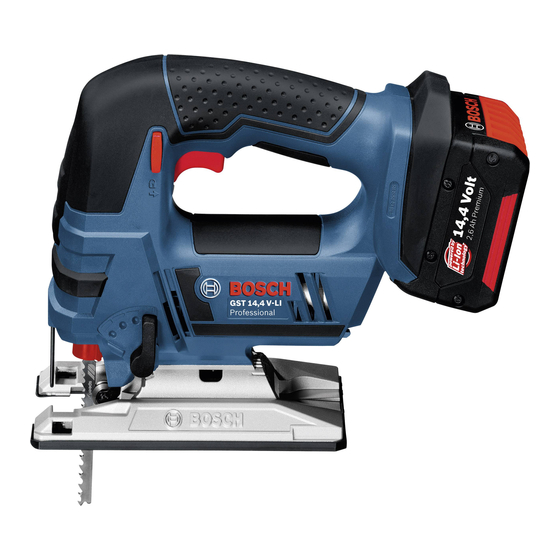OBJ_BUCH-1257-004.book Page 16 Monday, October 21, 2013 10:36 AM
16 | English
The lithium ion battery is protected against deep discharging
by the "Electronic Cell Protection (ECP)". When the battery is
empty, the machine is switched off by means of a protective
circuit: The inserted tool no longer rotates.
Do not continue to press the On/Off switch after the
machine has been automatically switched off. The bat-
tery can be damaged.
Observe the notes for disposal.
Removing the battery
The battery 3 is equipped with two locking levels that should
prevent the battery from falling out when pushing the battery
unlocking button 4 unintentionally. As long as the battery is
inserted in the power tool, it is held in position by means of a
spring.
To remove the battery 3, press the battery unlocking button 4
and pull the battery toward the rear out of the power tool. Do
not exert any force when doing this.
Battery Charge-control Indication (see figure A)
The three green LEDs of the battery charge-control indicator
17 indicate the charge condition of the battery 3. For safety
reasons, it is only possible to check the status of the charge
condition when the machine is at a standstill.
Press button 16 to indicate the charge condition. This is also
possible when the battery 3 is removed.
LED
Continuous lighting 3 x green
Continuous lighting 2 x green
Continuous lighting 1 x green
Flashing light 1 x green
When no LED lights up after pushing button 16, then the bat-
tery is defective and must be replaced.
Replacing/Inserting the Saw Blade
When mounting the saw blade, wear protective gloves.
Danger of injury when touching the saw blade.
Selecting a Saw Blade
An overview of recommended saw blades can be found at
the end of these instructions. Use only T-shank saw blades.
The saw blade should not be longer than required for the in-
tended cut.
Use a thin saw blade for narrow curve cuts.
Inserting the Saw Blade (see figure B)
Clean the shank of the saw blade before inserting it. An
unclean shank cannot be fastened securely.
Insert the saw blade 11 into the stroke rod 18 until it latches.
The SDS lever 12 automatically snaps to the rear and the saw
blade is locked. Do not manually press the lever 12 toward
the rear, otherwise you could damage the machine.
While inserting the saw blade, pay attention that the back of
the saw blade is positioned in the groove of the guide roller 9.
Check the tight seating of the saw blade. A loose saw
blade can fall out and lead to injuries.
1 609 92A 0C6 | (21.10.13)
Ejecting the Saw Blade (see figure C)
When ejecting the saw blade, hold the machine in such
a manner that no persons or animals can be injured by
the ejected saw blade.
Turn the SDS lever 12 forward towards the contact protector
14 to the stop. The saw blade is released and ejected.
Dust/Chip Extraction
Dusts from materials such as lead-containing coatings,
some wood types, minerals and metal can be harmful to
one's health. Touching or breathing-in the dusts can cause
allergic reactions and/or lead to respiratory infections of
the user or bystanders.
Certain dusts, such as oak or beech dust, are considered
as carcinogenic, especially in connection with wood-treat-
ment additives (chromate, wood preservative). Materials
containing asbestos may only be worked by specialists.
– As far as possible, use a dust extraction system suitable
for the material.
– Provide for good ventilation of the working place.
– It is recommended to wear a P2 filter-class respirator.
Observe the relevant regulations in your country for the
materials to be worked.
Prevent dust accumulation at the workplace. Dusts can
easily ignite.
Capacity
Connecting the Dust Extraction (see figures D–E)
2/3
Insert the vacuum connection 19 into the opening of base
plate 7.
1/3
Place a vacuum hose 20 (accessory) onto the vacuum con-
<1/3
nection 19. Connect the vacuum hose 20 with a vacuum
Reserve
cleaner (accessory). An overview for the connection of vari-
ous vacuum cleaners can be found at the end of these instruc-
tions.
To enable optimum dust extraction, use the splinter guard 21
if possible.
The vacuum cleaner must be suitable for the material being
worked.
When vacuuming dry dust that is especially detrimental to
health or carcinogenic, use a special vacuum cleaner.
Splinter Guard (see figure F)
The splinter guard 21 can prevent fraying of the surface while
sawing wood. The splinter guard can only be used with certain
saw blade types, and only at a cutting angle of 0°. When saw-
ing with the splinter guard, the base plate 7 may not be offset
to the rear for sawing close to edges.
Insert the splinter guard 21 into base plate 7 from the front.
Sliding Shoe (see figure G)
The plastic guide plate 6 of base plate 7 reduces sensitive sur-
faces from being scratched up. When cutting metal, use the
steel sliding shoe 22.
To mount the steel sliding shoe 22, slide it onto base plate 7
from the front.
Bosch Power Tools

